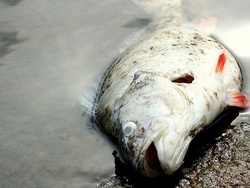Good news or bad news for the Gulf Dead Zone?

Last week, scientists for the National Oceanic and Atmospheric Administration found that the Gulf Dead Zone - an area of ocean unable to sustain sea life for much of the year - had reached 6,765 square miles, roughly the size of New Jersey.
Believe it or not, that was considered good news. Over the last few decades, the Gulf Dead Zone has been steadily expanding. The biggest culprit is thought to be runoff of fertilizers from farms further up the Mississippi River, which drain into the Gulf and eventually fuel an explosion of algae that rob oxygen -- a process known as hypoxia -- from ocean waters.
When the size of the Dead Zone shot up to over 7,700 square miles in 2010, many feared the BP oil spill was exacerbating Gulf hypoxia. That, combined with the massive floods along the Mississippi River earlier this year, caused scientists to fear the worst for 2011: a Dead Zone anywhere from 8,500 to 9,400 square miles.
Tropical Storm Dan appears to have broken up part of the Dead Zone. But it also led to choppy ocean waters which disrupted measurement of hypoxia, leading one of the lead scientist to conclude the 6,765 figure "probably underestimate[s]" the Dead Zone's true size.
But even if the Gulf Dead Zone's size this year turns out to be smaller than feared, scientists still agree it's a severe and growing problem. The 26-year average size of the Dead Zone heading into 2011 was 5,200 square feet, a figure dwarfed by even the lower estimates for 2011.
The growing stress on the Gulf Dead Zone -- which is already the largest in the world -- may be propelling it towards a breaking point. Dead Zones in the Black Sea and Caspian Sea both suffered ecological collapses after growing hypoxia stress, and new research suggests that Gulf waters are less able to recover each year.
As Larry McKinney of the Harte Research Institute for Gulf of Mexico Studies at Texas A&M University said to the AP last week:
The Gulf is really resilient, it can bounce back. But the dead zone stretches the rubber band every year and the question is when does the rubber band snap?"
Tags
Chris Kromm
Chris Kromm is executive director of the Institute for Southern Studies and publisher of the Institute's online magazine, Facing South.
